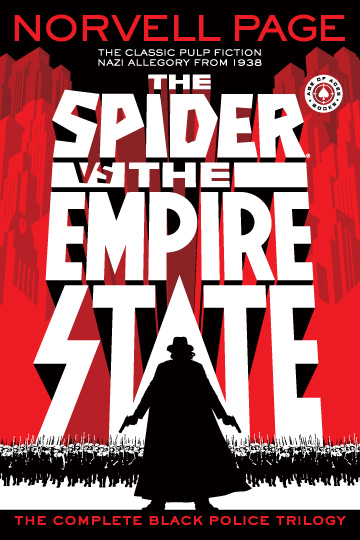By Norvell Page (writing as Grant Stockbridge)
Some works of fiction manage to transcend their own genre, speaking to a wider audience on a deeper level than the vast majority of their fellow works. In comic books, there is Watchmen. In fantasy, there is Lord of the Rings. In science fiction, there is Star Trek. I would argue that in the hero pulps there is “The Black Police Trilogy,” three consecutive tales of The Spider published in 1938. Now published under one cover as The Spider vs. the Empire State, these adventures marshal the lurid, escapist violence and mayhem of the pulp genre into a political allegory bringing home to America what was happening in the rest of the world and would very shortly give rise to World War II.
 |
| Original magazine cover |
I will doubtless have some kind of commentary on the trilogy as a whole once I have finished all three stories. There is, in fact, a wonderful historical introduction as a foreword by Thomas Krabacher, a political geographer at California State University, Sacramento, entitled “Blackshirts on Broadway,” which discusses the world of the 1930s, pulp fiction in general, and the backgrounds of the original publisher, editors, and author that gave birth to this story. A short but useful “Further Reading” list appears at the end. The modern, slicker cover illustration with its stark red, black, and white loses much of the character of the original pulp covers; those are reproduced inside, but only in greyscale. The original story illustrations are preserved as well, but not in their proper contexts, rather brought all together at the beginning of each book. All in all, I'll probably eventually acquire these stories in the Girasol Pulp Doubles reprint series as well, but it is interesting having them in what for all intents and purposes verges on a scholarly edition. Few pulp stories will ever merit such exalted treatment.
* * *
As a medievalist, I can't let Kirkpatrick's exclamation on p. 97 pass: "That's something out of the Middle Ages!" He's speaking of the new law allowing an individual to be declared an outlaw, whereupon he may be killed by anyone on sight, and by bringing proof of the death the killer can get a portion of the victim's wealth and property. Nooo..... It's really something out of the "Classical Period"! - Republican Rome, in fact. A few lines further on, the correct historical term is used - "proscription." It was instituted by the Dictator Sulla ca. 80 BC, but was used perhaps most infamously by the Triumvir Marc Antony to murder the great orator, statesman, and perennial thorn-in-his-side Cicero on 7 December 43 BC, a day that will live in infamy....

No comments:
Post a Comment